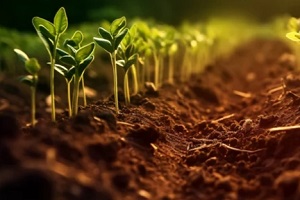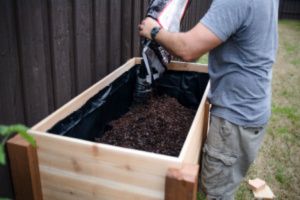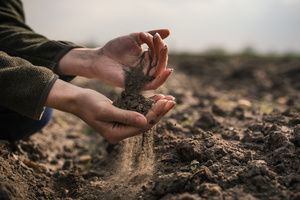 If you’re a beginner to the green-thumb club, understanding how to maintain different soil types properly might initially seem confusing. You may have beginner questions like, “What is loam soil? Why is it so important?” and, most importantly, “How can I improve it?”
If you’re a beginner to the green-thumb club, understanding how to maintain different soil types properly might initially seem confusing. You may have beginner questions like, “What is loam soil? Why is it so important?” and, most importantly, “How can I improve it?”
To answer these questions, we have compiled a list of eleven key tips to guide you on your journey to a healthier garden through improved loam soil. Loam is a balanced blend of sand, silt, and clay that offers optimal conditions for plant growth.
Known for its nutrient-rich profile and excellent moisture-holding capacity, loam provides the perfect platform for your plants to flourish.
Whether you’re planning to grow vibrant flowers, lush lawns, or bountiful vegetable patches, improving the loam in your garden could be the game-changer you’ve been waiting for.
1. Understanding Your Soil Composition
The first step in improving loam soil involves knowing what you’re working with. Loam is a combination of sand, silt, and clay, ideally in roughly equal proportions, but can vary widely from one place to another.
You can determine your soil type by performing a simple jar test at home or seeking a professional soil analysis. Once you know your soil’s composition, you can better understand what adjustments might be necessary.
2. Regular Soil Testing
The quality of loam soil is dynamic; it can change over time based on various factors such as nutrient depletion and weather conditions. Regular soil testing is vital to track the status of your soil.
These tests can provide valuable information about nutrient levels, pH, and organic matter content. Based on the results, you can adjust your soil management strategies to keep your loam at its best.
3. Balancing Soil pH
The pH level of your soil can significantly influence the availability of nutrients for your plants. Most plants prefer a slightly acidic to neutral pH range (6.0 – 7.0). If your soil test reveals that your loam soil is too acidic or alkaline, you can add materials like lime (to raise pH) or sulfur (to lower pH) to help balance it out.
Remember, changes in soil pH should be made gradually and tested frequently to avoid shocking your plants.
4. Incorporating Organic Matter
 Adding organic matter like compost, well-rotted manure, or leaf mold can enhance the fertility and structure of your loam soil. Organic matter introduces beneficial microbes, improves soil water-holding capacity, and aids in nutrient retention and supply.
Adding organic matter like compost, well-rotted manure, or leaf mold can enhance the fertility and structure of your loam soil. Organic matter introduces beneficial microbes, improves soil water-holding capacity, and aids in nutrient retention and supply.
Incorporating a few inches of organic matter into the top layer of your soil annually can do wonders for your garden’s productivity.
5. Proper Watering Practices
Loam soil is prized for its ability to retain moisture while still providing good drainage. However, improper watering can still lead to issues like waterlogging or drought stress. Water your garden based on the specific needs of your plants and the local weather conditions.
Generally, a deep watering once or twice a week is preferable to daily light watering, as it encoorages deeper root growth.
6. Employing Crop Rotation
If you’re growing vegetables or annual flowers, consider crop rotation. This practice involves growing different types of plants in the same area over several seasons.
Crop rotation helps prevent the depletion of specific nutrients, breaks the lifecycle of common pests and diseases, and promotes a balanced soil ecosystem.
7. Cover Cropping and Green Manure
Cover crops, also known as green manure, are plants grown primarily to improve soil health. They prevent soil erosion, suppress weeds, and add valuable organic matter when dug back into the soil. Leguminous cover crops like clover or vetch can also fix atmospheric nitrogen, enriching your soil further.
8. Avoiding Soil Compaction
Soil compaction reduces the soil’s pore space, which hampers root growth and limits the movement of air and water. Avoid working in your garden when the soil is wet, as this can cause compaction. Also, try to minimize unnecessary foot or equipment traffic. If your soil does become compacted, you can improve it by adding organic matter and considering practices like double digging or creating raised beds.
9. Mulching Your Garden
Mulching is a practice where a protective material layer is spread on top of the soil. Organic mulches like compost, straw, or wood chips can help maintain soil moisture, regulate soil temperature, reduce weed growth, and over time, break down to add nutrients back into the soil. Mulching your garden can keep your loam soil in top shape and make your garden more resilient to weather extremes.
10. Implementing Companion Planting
Companion planting involves growing certain plants together for mutual benefit. Some plant combinations can help deter pests, improve nutrient uptake, and even enhance flavor (in the case of vegetables and herbs). By effectively utilizing companion planting, you can increase your garden’s overall health and vitality, indirectly benefiting your loam soil.
11. Introducing Beneficial Insects and Organisms
 Healthy soil is teeming with life, from earthworms and insects to microscopic bacteria and fungi. These creatures are crucial in breaking down organic matter, aerating the soil, and controlling pests.
Healthy soil is teeming with life, from earthworms and insects to microscopic bacteria and fungi. These creatures are crucial in breaking down organic matter, aerating the soil, and controlling pests.
Introducing beneficial insects (like ladybugs and lacewings) or organisms (like earthworms or mycorrhizal fungi) can boost your soil’s health and productivity.
Trust Dirt Connections for Your Soil-Related Needs
Your journey to gardening success begins right beneath your feet, with the health and balance of your loam soil. In following these twelve tips, you can nurture your soil and, by extension, your plants to their fullest potential. Yet, sometimes, despite our best efforts, our soil may need a little more help than compost and crop rotation can provide. That’s where Dirt Connections comes into play.
Dirt Connections is your go-to solution for premium quality fill dirt, proudly serving Virginia and Maryland. Whether you’re starting a new garden, leveling a lawn, or working on a construction project, their fill dirt can provide a solid, nutrient-rich foundation for your endeavors.
Ready to take your garden to the next level? Reach out to them at (703) 940-9949 in Virginia, (301) 691-3215 in Maryland, or get a free quote online today. Let the knowledgeable team at Dirt Connections give your soil— and your garden—the superior quality loam it deserves.
Summary

Dirt Connections was started with one goal in mind: providing quality residential and commercial construction services to clients on time and on budget. Reach out for more information on how we can support your next project.
For your convenience our estimates are free and by appointment. Call 703-940-9949 for a free estimate today!









































